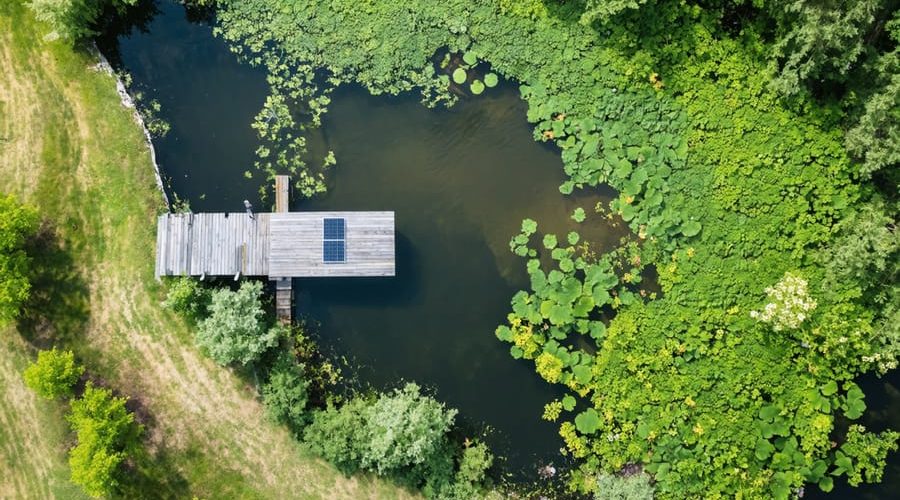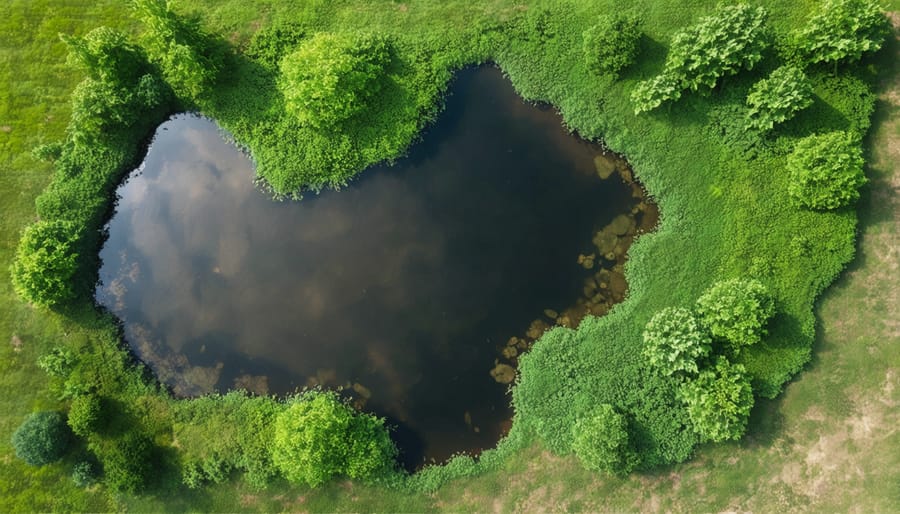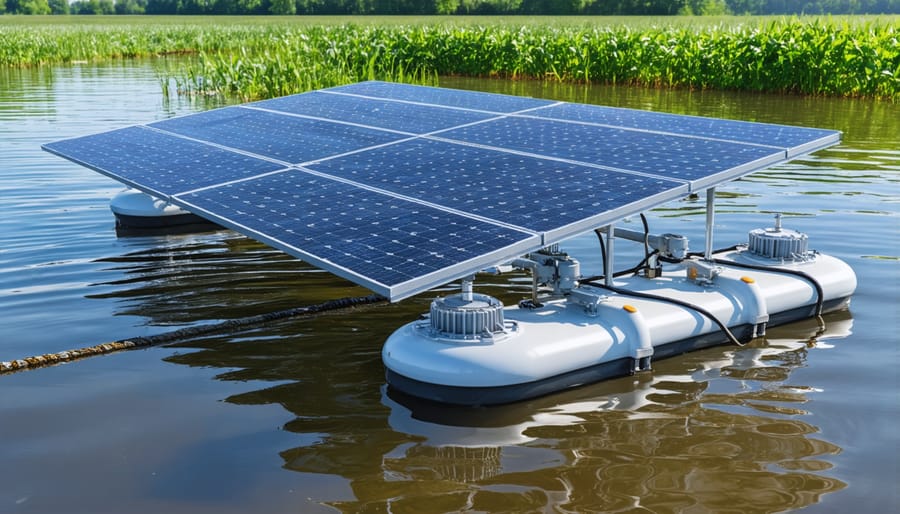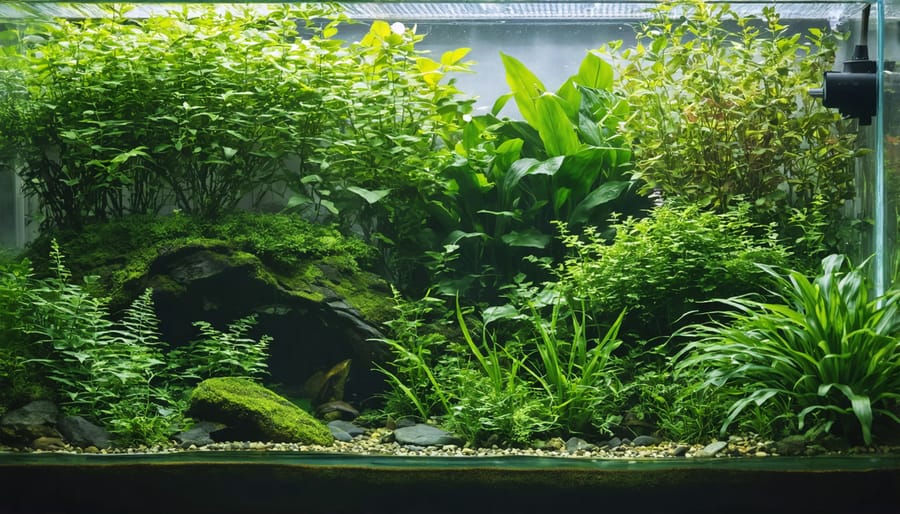
Transform Your 1-Acre Pond into a Self-Sustaining Paradise
Transform a one-acre pond into a thriving ecosystem by combining natural features with strategic design elements. Create multiple depth zones – shallow marshy areas for wetland plants, medium-depth regions for aquatic vegetation, and deep sections exceeding 8 feet for fish habitat and temperature regulation. Border the pond with native plants like cattails, rushes, and water lilies to establish natural filtration systems while providing essential wildlife habitats.
Install an aeration system powered by solar panels to maintain healthy oxygen levels and prevent algae overgrowth. Position fountains or waterfalls strategically to enhance both water circulation and visual appeal. Add underwater structure like submerged logs, rock piles, and aquatic shelves to support fish populations and create diverse microhabitats.
Design accessible features around the pond’s perimeter – a fishing dock, observation deck, or peaceful sitting area surrounded by native landscaping. Consider incorporating a beach area or natural swimming zone using gradual slopes and appropriate substrate materials. These thoughtful additions transform a basic pond into an engaging outdoor destination that supports local wildlife while providing recreational opportunities for years to come.
Remember to balance aesthetics with functionality as you plan your pond project. The right combination of natural elements and carefully selected features will create a sustainable aquatic environment requiring minimal maintenance.
Smart Design Features for a Sustainable 1-Acre Pond
Natural Filtration Zones
Natural filtration zones are your pond’s eco-friendly cleaning crew, working tirelessly to maintain crystal-clear water while reducing dependency on mechanical equipment. When planning your 1-acre pond, dedicating about 15-20% of the surface area to these zones is ideal for effective ecosystem pond building.
Start by creating a shallow bog area at your pond’s edge, ranging from 6 to 12 inches deep. Plant it with water-loving species like cattails, rushes, and iris, which naturally filter nutrients and excess waste from the water. These plants’ root systems act as natural filters, trapping debris and processing nutrients that would otherwise feed algae.
Consider designing multiple filtration zones around your pond’s perimeter. A stepped approach works well – begin with deeper marginal plants near the pond’s edge, then transition to shallow-water plants, and finally to moisture-loving plants at the water’s edge. This creates a natural transition that not only filters water but also provides valuable wildlife habitat.
For maximum effectiveness, position these zones where water naturally flows into your pond. This ensures that incoming water passes through the natural filtration system before entering the main body of water. Add gravel and river rock of varying sizes to these areas to provide additional surface area for beneficial bacteria to colonize, further enhancing your pond’s natural filtering capacity.
Strategic Depth Variations
Creating varying depths in your 1-acre pond isn’t just about aesthetics – it’s essential for maintaining a healthy ecosystem. A well-designed pond typically features three distinct zones: shallow, intermediate, and deep.
The shallow areas, ranging from 6 inches to 2 feet deep, serve as crucial habitats for emergent plants and provide safe spaces for smaller fish and amphibians. These areas also warm up quickly in spring, supporting early-season biological activity and offering safe spawning grounds.
Your intermediate zone, typically 2-4 feet deep, is perfect for submerged plants and creates essential feeding areas for fish. This depth also helps maintain stable water temperatures and supports a diverse range of aquatic life.
The deep zone, ideally 6-8 feet, acts as a sanctuary for fish during extreme weather conditions. In summer, it provides a cool retreat, while in winter, it prevents the pond from freezing solid. This depth also helps maintain stable water temperatures throughout your pond.
For optimal ecosystem balance, aim to make about 20% of your pond shallow, 40% intermediate, and 40% deep. This distribution creates natural temperature gradients and supports various wildlife needs. Remember to gradually slope between these zones to prevent erosion and create safe passages for pond inhabitants to move between different depths.

Energy-Efficient Equipment Solutions
Solar-Powered Aeration Systems
Solar-powered aeration systems have revolutionized how we maintain healthy pond ecosystems, offering sustainable aeration solutions that work harmoniously with nature. These innovative systems use solar panels to power air compressors, which pump life-giving oxygen into your pond throughout the daylight hours.
Modern solar aerators come with battery backup options, ensuring your pond stays oxygenated even during cloudy periods. For a one-acre pond, you’ll typically need a system rated between 1/4 to 1/2 horsepower, depending on your pond’s depth and fish population. The best part? Once installed, these systems operate virtually cost-free, using only the sun’s energy.
Installation is surprisingly straightforward – mount the solar panels in a south-facing location, connect them to the compressor unit, and position the diffusers strategically around your pond. Many systems now come with smart controllers that adjust aeration levels based on water temperature and oxygen demands.
The benefits extend beyond just oxygen circulation. Solar aerators help reduce algae growth, prevent stratification, and keep the water moving naturally. This movement is particularly beneficial in breaking down organic matter and maintaining consistent temperatures throughout your pond. Plus, the gentle bubbling creates a peaceful atmosphere that many pond owners find adds to their backyard’s ambiance.
These eco-friendly systems typically pay for themselves within a few years through energy savings, making them a smart investment for any pond owner looking to maintain their water feature sustainably.

Smart Filtration Technology
A well-designed filtration system is essential for maintaining crystal-clear water in your one-acre pond while keeping energy costs manageable. Modern smart filtration technology offers efficient solutions that work in harmony with your pond’s natural ecosystem.
The heart of smart filtration lies in multi-stage systems that combine mechanical and biological filtration. These systems typically start with pre-filters to catch larger debris, followed by bio-chambers filled with beneficial bacteria that break down harmful compounds. What makes them “smart” is their ability to adjust filtration rates based on water conditions, saving energy during periods of lower demand.
Variable-speed pumps are game-changers for large ponds. These intelligent pumps automatically adjust their power output based on your pond’s needs, potentially reducing energy consumption by up to 70% compared to traditional single-speed pumps. Many models can be controlled through smartphone apps, allowing you to monitor and adjust settings remotely.
UV clarifiers with smart sensors can turn on only when needed, targeting algae growth without constant operation. Some advanced systems even include water quality monitors that alert you when parameters like pH or oxygen levels need attention, helping you maintain optimal conditions without excessive equipment use.
Consider incorporating wetland filtration zones alongside mechanical systems. These natural filters use specific plants to purify water while creating beautiful transitions between your pond and surrounding landscape, reducing the workload on your mechanical filters.
Eco-Friendly Pump Solutions
When it comes to maintaining a one-acre pond, choosing the right pump solution can make a huge difference in both environmental impact and operating costs. Modern energy-efficient pump systems have revolutionized how we manage larger water features, offering impressive performance while consuming significantly less electricity.
Solar-powered pumps are becoming increasingly popular for one-acre ponds, especially in sunny locations. These systems can handle the circulation needs of larger bodies of water while running completely off-grid. Many models now come with battery backup systems, ensuring consistent operation even during cloudy periods.
Variable-speed pumps are another game-changer, automatically adjusting their power output based on your pond’s needs. During cooler months or at night, these smart pumps reduce their operating speed, leading to substantial energy savings without compromising water quality.
Consider implementing a hybrid system that combines traditional electric pumps with renewable energy sources. This setup can include timers and sensors that optimize pump operation based on factors like temperature, oxygen levels, and time of day. Many pond owners report energy savings of up to 50% after switching to these eco-friendly solutions.
For maximum efficiency, pair your pump system with natural filtration methods like constructed wetlands or bog filters. This reduces the workload on your pumps while creating additional wildlife habitat around your pond.
Natural Maintenance Strategies
Beneficial Plant Selection
Choosing the right beneficial aquatic plants can transform your acre pond into a self-sustaining ecosystem. Start with submerged oxygenators like Hornwort and Elodea, which help maintain clear water by absorbing excess nutrients and providing oxygen. These underwater workhorses are your first line of defense against algae growth.
Around the pond’s edges, incorporate marginal plants such as Cattails, Rush, and Iris. These plants not only create natural filtration by trapping sediment but also provide essential habitat for wildlife. Their extensive root systems help stabilize the bank and prevent erosion.
Floating plants like Water Lilies and Lotus serve multiple purposes – they shade the water, reducing algae growth, while their leaves provide shelter for fish and landing pads for dragonflies. Aim to cover about 30-40% of your pond’s surface with floating vegetation.
Don’t forget about deep-water plants like American Pondweed and Watershield. These plants are excellent at recycling nutrients from the bottom of your pond and creating oxygen-rich environments for fish.
For the best results, include a mix of all these plant types. This diversity creates a balanced ecosystem where each plant plays its part in maintaining water quality naturally, reducing the need for chemical treatments and excessive maintenance.

Fish Stock Management
Managing fish populations in your one-acre pond is crucial for maintaining a healthy, balanced ecosystem. Start by stocking your pond with a mix of predator and prey fish species. A popular combination includes largemouth bass, bluegill, and catfish, which create a natural food chain that helps control populations.
For optimal health, stock approximately 100 bluegill, 50-75 catfish, and 50 bass per acre. This ratio allows the fish to thrive while preventing overpopulation. Remember that bluegill reproduce quickly, providing a sustainable food source for bass, while catfish help keep the pond bottom clean.
Monitor your fish population regularly by observing their size and behavior. If you notice stunted growth or too many small fish, you may need to harvest some to maintain balance. Adding habitat structures like sunken trees or artificial reefs gives smaller fish hiding places and creates fishing hotspots.
Feed your fish supplementally only when necessary, as overfeeding can lead to water quality issues. During warmer months, fish naturally feed on insects, aquatic plants, and smaller fish. Consider installing an aerator to maintain adequate oxygen levels, especially during summer when water temperatures rise.
Keep records of fish additions and removals to track population changes over time. This information helps you make informed decisions about future stocking needs and maintains the perfect balance for a thriving pond ecosystem.
Seasonal Maintenance Tips
Keeping your 1-acre pond healthy throughout the year doesn’t have to be complicated. In spring, focus on removing dead vegetation and checking water quality as temperatures rise. A long-handled rake and basic water testing kit are all you need to get started. Add beneficial bacteria to jump-start the biological cycle after winter dormancy.
Summer maintenance revolves around managing aquatic plant growth. Remove about 30% of floating vegetation monthly to prevent overgrowth, and trim back marginal plants as needed. Keep an eye on water levels and top off during dry spells to maintain a healthy ecosystem.
Fall is crucial for preparing your pond for winter. Remove fallen leaves before they sink and decompose – a simple net stretched across problem areas works wonders. Cut back dying plant material and remove any annual aquatic plants that won’t survive winter.
Winter maintenance is minimal but important. Keep a small area free of ice using a floating de-icer to allow for gas exchange. Avoid breaking ice directly on the pond, as this can harm hibernating fish. If you have a fountain or aerator, raise it closer to the surface to maintain oxygen levels without disturbing the warmer water below.
Year-round, monitor your shoreline for erosion and repair as needed with natural materials like rocks or native plants. Remember, a well-maintained pond becomes more self-sustaining over time, requiring less intervention as its ecosystem matures.
Creating and maintaining a one-acre pond is an exciting journey that brings both challenges and rewards. As we’ve explored throughout this guide, the key to success lies in finding the perfect balance between aesthetic appeal and ecological sustainability. Remember that your pond is more than just a water feature – it’s a living ecosystem that can thrive with proper planning and care.
By incorporating natural filtration methods, choosing appropriate plants, and creating diverse habitats for wildlife, you can establish a self-sustaining environment that requires less maintenance over time. The investment in proper equipment and sustainable practices may seem substantial initially, but it pays dividends through reduced operating costs and a healthier pond system.
As you implement these ideas, keep in mind that every pond is unique, and it may take some time to find the perfect combination of elements that work for your specific situation. Don’t be afraid to experiment and adjust your approach based on how your pond responds. Monitor water quality regularly, maintain your equipment properly, and stay attentive to the changing needs of your aquatic ecosystem.
Most importantly, embrace the journey of pond ownership. Whether you’re creating a serene fishing spot, a wildlife haven, or a beautiful landscape feature, your one-acre pond can become a source of endless enjoyment while contributing positively to the local environment. With proper care and sustainable management practices, your pond will continue to evolve and improve, providing years of pleasure for you and future generations.
